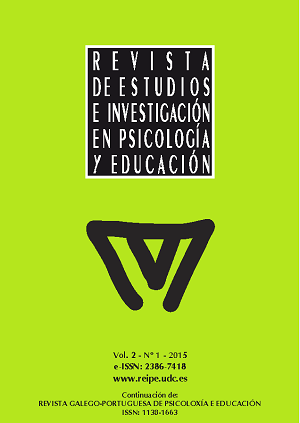Atacar será a melhor defesa? A influência das experiências precoces e da paranoia na agressividade dos jovens açorianos || Is the offence the best defense? Influences of childhood experiences and paranoia in the aggression in Azorean youths
Contenido principal del artículo
DOI:
https://doi.org/10.17979/reipe.2015.2.1.105Resumen
Descargas
Detalles del artículo
Referencias
Barreto Carvalho, C., Sousa, M., da Motta, C., Pinto-Gouveia, J., Caldeira, S. N., Peixoto, E. B., … Fenigstein, A. (2015). Paranoia in the general population: A revised version of the General Paranoia Scale for adults. Clinical Psychologist, n/a–n/a. http://doi.org/10.1111/cp.12065
Bifulco, A., Bernazzani, O., Moran, P. M., & Jacobs, C. (2005). The childhood experience of care and abuse questionnaire (CECA.Q): validation in a community series. The British Journal of Clinical Psychology / the British Psychological Society, 44(Pt 4), 563–81. http://doi.org/10.1348/014466505X35344
Bowers, E. P., Gestsdottir, S., Geldhof, G. J., Nikitin, J., von Eye, A., & Lerner, R. M. (2011). Developmental trajectories of intentional self-regulation in adolescence: The role of parenting and implications for positive and problematic outcomes among diverse youth. Journal of Adolescence, 34(6), 1193–1206. http://doi.org/10.1016/j.adolescence.2011.07.006
Buss, A. H., & Perry, M. (1992). The aggression questionnaire. Journal of Personality and Social Psychology, 63(3), 452–459. http://doi.org/10.1037/0022-3514.63.3.452
Buss, D. M. (2011). Evolutionary psychology: The new science of the mind (4th edition). Upper Saddle River, NJ: Pearson.
Buss, D. M. (2005). The handbook of evolutionary psychology. Hoboken, NJ: John Wiley & Sons,
Carvalho, C. B., da Motta, C., Pinto-Gouveia, J., & Peixoto, E. (2015). Influence of Family and Childhood Memories in the Development and Manifestation of Paranoid Ideation. Clinical Psychology & Psychotherapy, n/a–n/a. http://doi.org/10.1002/cpp.1965
Carvalho, C. B., Pereira, V., Sousa, M., Motta, C. da, Pinto-Gouveia, J., Caldeira, S. N., … Fenigstein, A. (2014). Paranoia in the General Population: a revised version of the General Paranoia Scale for adolescents. European Scientific Journal, 2(23), 1–15.
Carvalho, C. B., Pinto-Gouveia, J., Peixoto, E., & Motta, C. da. (2014, June 15). Paranoia as a Continuum in the Population. Asian Journal of Humanities and Social Studies, 2 (3), 382-391.
Combs, D. R., Michael, C. O., & Penn, D. L. (2006). Paranoia and emotion perception across the continuum. The British Journal of Clinical Psychology / the British Psychological Society, 45(Pt 1), 19–31. http://doi.org/10.1348/014466505X29099
Cunha, M., Xavier, A., Martinho, M. I., & Matos, M. (2014). Measuring positive emotional memories in adolescents: Psychometric properties and confirmatory factor analysis of the Early Memories of Warmth and Safeness Scale. International Journal of Psychology and Psychological Therapy, 14(2), 245–259.
Cunha, O., & Gonçalves, R. A. (2012). Análise confirmatória fatorial de uma versão portuguesa do Questionário de Agressividade de Buss-Perry. Laboratório de Psicologia, 10(1), 3–17.
Ellett, L., Lopes, B., Chadwick, P., (2003). Paranoia in a Nonclinical Population of College Students. The Journal of Nervous and Mental Disease, 191(7), 425–430. http://doi.org/10.1097/01.NMD.0000081646.33030.EF
Fenigstein, A., & Vanable, P. (1992). Paranoia and self-consciousness. Journal of Personality and Social Psychology, 62(1), 129–38. http://doi.org/10.1037/0022-3514.62.1.129
Freeman, D., Pugh, K., Vorontsova, N., Antley, A., & Slater, M. (2010). Testing the continuum of delusional beliefs: an experimental study using virtual reality. Journal of Abnormal Psychology, 119(1), 83–92. http://doi.org/10.1037/a0017514
Gilbert, P. (1998). Evolutionary psychopathology: why isn’t the mind designed better than it is? The British Journal of Medical Psychology, 71 (Pt 4)(4), 353–373. http://doi.org/10.1111/j.2044-8341.1998.tb00998.x
Gilbert, P., Allan, S., & Goss, K. (1996). Parental Representations, Shame, Interpersonal Problems, and Vulnerability to Psychopathology. Clinical Psychology & Psychotherapy, 3(1), 23–34. http://doi.org/10.1002/(SICI)1099-0879(199603)3:1<23::AID-CPP66>3.3.CO;2-F
Gilbert, P., Boxall, M., Cheung, M., & Irons, C. (2005). The relation of paranoid ideation and social anxiety in a mixed clinical population. Clinical Psychology & Psychotherapy, 12(2), 124–133. http://doi.org/10.1002/cpp.438
Heaven, P. C. L., Ciarrochi, J., & Leeson, P. (2009). The longitudinal links between shame and increasing hostility during adolescence. Personality and Individual Differences, 47(8), 841–844. http://doi.org/10.1016/j.paid.2009.07.002
Kimonis, E. R., Frick, P. J., Fazekas, H., & Loney, B. R. (2006). Psychopathy, aggression, and the processing of emotional stimuli in non-referred girls and boys. Behavioral Sciences & the Law, 24(1), 21–37. http://doi.org/10.1002/bsl.668
Kline, R. B. (2011). Principles and Practice of Structural Equation Modeling. Structural Equation Modeling (Third Edition). New York: Guilford Press.
Makin-Byrd, K., & Bierman, K. L. (2013). Individual and Family Predictors of the Perpetration of Dating Violence and Victimization in Late Adolescence. Journal of Youth and Adolescence, 42(4), 536–550. http://doi.org/10.1007/s10964-012-9810-7
Morrison, K. E., Rodgers, A. B., Morgan, C. P., & Bale, T. L. (2014). Epigenetic mechanisms in pubertal brain maturation. Neuroscience, 264, 17–24. http://doi.org/10.1016/j.neuroscience.2013.11.014
Nuevo, R., Chatterji, S., Verdes, E., Naidoo, N., Arango, C., & Ayuso-Mateos, J. L. (2012). The continuum of psychotic symptoms in the general population: a cross-national study. Schizophrenia Bulletin, 38(3), 475–85. http://doi.org/10.1093/schbul/sbq099
Pinto-gouveia, J., Matos, M., Castilho, P., & Xavier, A. (2012). Differences between Depression and Paranoia: The Role of Emotional Memories, Shame and Subordination. Clinical Psychology & Psychotherapy, 21(1), 49–61. http://doi.org/10.1002/cpp.1818
Raffaelli, M., Crockett, L. J., & Shen, Y.-L. (2005). Developmental stability and change in self-regulation from childhood to adolescence. The Journal of Genetic Psychology, 166(1), 54–75. http://doi.org/10.3200/GNTP.166.1.54-76
Richter, A., Gilbert, P., & McEwan, K. (2009). Development of an early memories of warmth and safeness scale and its relationship to psychopathology. Psychology & Psychotherapy, 82(Pt 2), 171–184. http://doi.org/10.1348/147608308X395213
Sousa, M., Barreto Carvalho, C., da Motta, C., Cabral, J., Pereira, V., Caldeira, S., & Peixoto, E. (2015). Characterization and Predictors of Paranoid Ideation in Youths. International Journal of Psychological and Behavioral Sciences, 09(2).
Steinberg, L. (2007). Risk Taking in Adolescence: New Perspectives from Brain and Behavioral Science. Current Directions in Psychological Science, 16, 55-59. http://doi.org/10.1111/j.1467-8721.2007.00475.x


